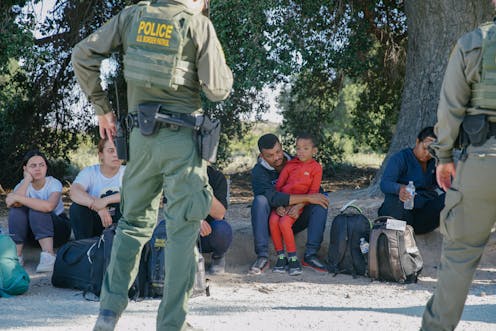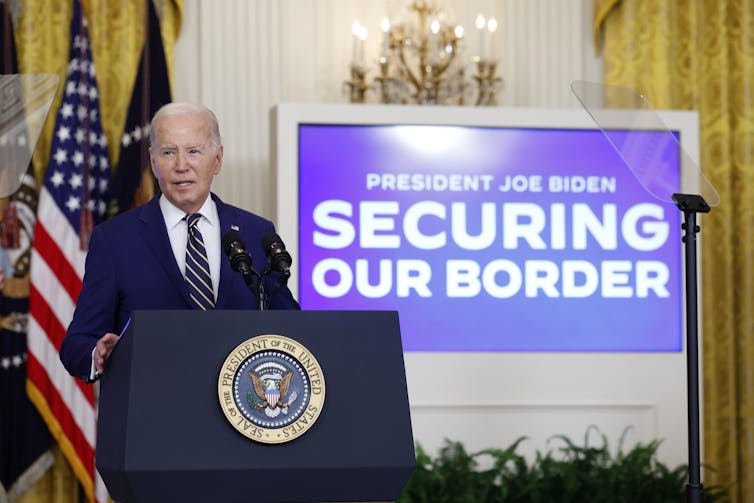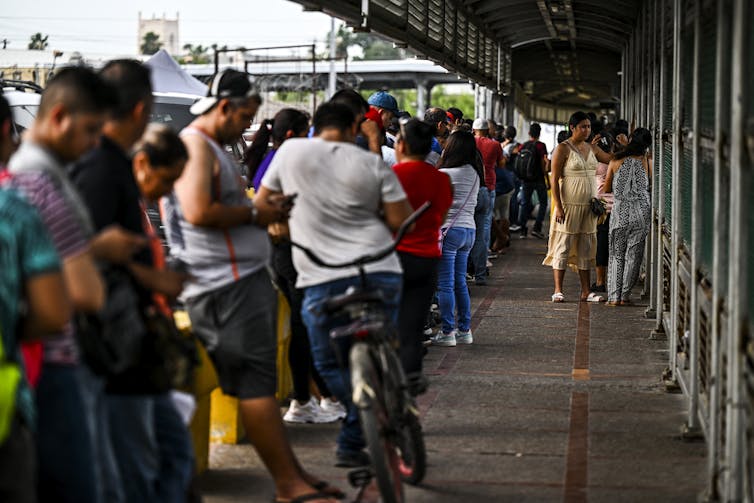Biden’s immigration order won’t fix problems quickly – 4 things to know about what’s changing
Biden’s executive order won’t apply to undocumented minors who enter the US alone. And the order will require the help of Mexico and other countries.

Immigration is a top issue in the upcoming presidential election – and President Joe Biden’s new executive order restricting migrants’ ability to apply for asylum is likely to further elevate the subject in national politics.
The number of undocumented migrants crossing the U.S.-Mexico border has soared in recent years, with 249,785 arrests taking place along the border in December 2023. That marks a 13% rise from the 222,018 migrants arrested by the Border Patrol along the U.S.-Mexico border in December 2022.
Jean Lantz Reisz, an immigration law scholar at the University of Southern California, explains four key things to know about how this executive order will take effect and influence immigration trends.

1. The executive order is basically an asylum ban
Biden announced his executive order on June 4, 2024. It prevents everyone who crosses the U.S.-Mexico border without a visa, and not passing through an official port of entry, from seeking asylum. It goes into effect when the number of people crossing the U.S.-Mexico border each day exceeds an average of 2,500.
There have generally been more than 2,500 people without visas crossing the U.S.-Mexico border for each day of Biden’s entire presidency.
Effectively, this is a ban on asylum, meaning the legal right for undocumented immigrants to remain in the U.S. because of the harm they face in their home countries.
Under Biden’s order, some undocumented migrants who express a fear of returning to their home countries may be eligible for other kinds of legal protections – for example, legal protections intended for torture survivors.
In order to get this special legal protection, migrants would have to show U.S. border and immigration officials a lot of evidence outlining the danger they would face in their home countries. They would need to show more evidence than is required for asylum-seekers. Migrants will generally not have this evidence on hand and, as a result, will not receive any kind of legal protection or chance to stay in the U.S.
Over the past decade, including during Biden’s presidency, approximately two-thirds of people who applied for asylum while they were in deportation proceedings were granted asylum or another kind of legal protection that allowed them to stay in the U.S., according to the Transactional Records Access Clearinghouse, a data organization at Syracuse University.
Biden’s order means that many individuals who previously would have been entitled to asylum, per U.S. law, will now be expelled to Mexico or their home countries without the opportunity to apply for asylum.
2. This could lead to a rise in undocumented minors crossing the border solo
Many individuals who reach the U.S.-Mexico border and cross into the U.S. without a visa or an online appointment to meet with U.S. Customs and Border Protection will be quickly turned back and deported to Mexico or returned to their home countries. The U.S. will need cooperation from Mexico to be able to turn back non-Mexican citizens to Mexico. Mexico currently accepts Cuban, Haitian, Nicaraguan and Venezuelan citizens deported from the U.S.
In December 2023, about one-fourth of the migrants apprehended at the U.S.-Mexico border were from Mexico, while another one-fourth were from El Salvador, Guatemala or Honduras. The largest group of apprehended migrants were from other countries, including Venezuela and China.
Biden’s order will not apply to people who are under 18 and cross the U.S.-Mexico border without a parent or guardian. These children will be detained and placed in deportation proceedings where they can seek asylum or other immigration protections.
This creates the risk that desperate parents will send their children alone across the border. This happened from March 2020 through May 2023, when COVID-19-related border restrictions, called Title 42, similarly banned undocumented immigrants crossing the U.S.-Mexico border from seeking asylum. This restriction did not apply to unaccompanied minors. It resulted in a sharp spike in undocumented minors crossing the U.S. southern border from 2020 through 2023.
3. Biden is taking a page out of Donald Trump’s book
Biden is basing this executive order, in part, on an immigration statute called 212(f), which gives the president very broad authority to suspend the entry of certain noncitizens because it would be “detrimental” to U.S. interests.
Former President Donald Trump cited this law when he implemented a travel ban that temporarily suspended the entry of noncitizens from seven countries, including five Muslim-majority countries, in 2017. The U.S. Supreme Court upheld the third version of this ban as being lawful in 2018. Biden reversed the ban in 2021.

4. The executive order won’t be so easy to implement
Biden’s ability to actually reduce the number of migrants who cross the U.S.-Mexico border without a visa or any other kind of authorization will depend on several factors.
The president will need Mexico to accept more deported citizens of different countries in order for the U.S. to swiftly turn away migrants. U.S. Border Patrol and immigration agencies have also been overwhelmed by the large influx of undocumented migrants crossing the border. They cannot easily apprehend and screen all migrants or quickly respond to migrants’ applications to stay in the U.S. in immigration courts, which have a historic and massive backlog.
Quickly processing and deporting migrants back to their home countries will also be an obstacle that could limit the order’s effectiveness. U.S. immigration officials will first need to determine whether someone who states a fear of returning to their country qualifies for other kinds of legal protection that are not asylum.
Deporting a Mexican citizen or a Cuban, Venezuelan, Nicaraguan or Haitian citizen can be done quickly and easily, since Mexico will accept them. Deporting migrants from other countries would require their governments to help them get the necessary travel documents and, in most cases, arrange airplane flights.
Still, Biden’s order may deter many migrants who plan to cross the border in the hopes of being allowed to remain in the U.S. and seek asylum.
Jean Lantz Reisz does not work for, consult, own shares in or receive funding from any company or organization that would benefit from this article, and has disclosed no relevant affiliations beyond their academic appointment.
Read These Next
Miami’s new mayor faces a housing affordability crisis, city charter reform and a shrinking budget
Eileen Higgins won a hard-fought election to become Miami’s new mayor. Now for the hard part – governing…
Understanding climate change in America: Skepticism, dogmatism and personal experience
Real skeptics study the evidence and ask questions, rather than taking political dogma on faith. Experiencing…
Rest is essential during the holidays, but it may mean getting active, not crashing on the couch
Unwinding can be hard during the holidays for many reasons. Building in time to recharge through active…






